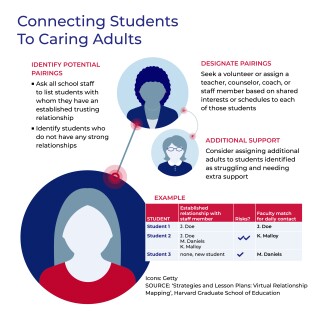It’s tempting to put students’ social, emotional, and mental well-being on the back burner as schools scramble to make up for lost learning and navigate the tough logistical and political challenges of safely opening school buildings. But ignoring social emotional learning could be a recipe for disaster.
The fact is: Children can’t process and retain new information if their brains are overwhelmed with anxiety.
That’s especially true now for students who are feeling deeply stressed by the coronavirus, the economic recession, and the racial unrest that is sweeping the country.
While adopting a comprehensive, evidence-based SEL curriculum is best, if a school doesn’t have one, that doesn’t mean it’s too late to introduce social emotional learning. There are ways to weave SEL into the school day without overhauling established plans and adopting new SEL curricula. While it’s hard to teach children social and emotional skills while they are working remotely or sitting in classrooms where everyone is spaced six feet apart and wearing a mask, it’s not impossible
Seventh in a series of eight installments.
These times are unprecedented. Through eight installments, Education Week explores the steps administrators need to take to ensure the safety of students and faculty.
How We Go Back to School is supported in part by the Chan Zuckerberg Initiative.
Ensuring that students are connected to their peers and have strong supporting relationships with adults in school will go a long way toward helping them cope and getting to a place mentally where they are ready to learn.
—The Editors
Deep Dive: Why Students Need Social-Emotional Learning Now
Downloadable Guide: 6 Exercises for Teaching SEL This School Year
CONNECTING WITH STUDENTS

Strong relationships will be essential to students’ academic success and well-being this coming school year. And the beginning of the semester is the time to develop the personal connections that students will need to sustain them through the uncertainties ahead.
That’s tough with schools either operating remotely, alternating online instruction with in-person classes, or closing due to an outbreak. Schools can take steps to keep students connected with school by intentionally mapping out adult relationships for them, enacting buddy systems for peer-to-peer ties, maintaining regular check-ins, and reaching out to parents and family.
Deep Dive: How to Build Relationships With Students During COVID-19
Downloadable Guide: Language for Forging Online Connections With Students
THE NEW SOCIAL SKILLS

How can kids learn social skills when they’re working remotely? Or when they’re wearing masks in class and staying six feet apart from one another? Ensuring that students continue to develop critical social-emotional skills in a socially distanced world will require administrators and teachers to not just rethink existing approaches to social learning but also teach children to navigate the new social skills that are needed for life during the pandemic.
That mean re-evaluating the risks and benefits of activities, like singing, to promote social emotional learning, teaching students to give fist bumps and air hugs, and inventing new ways to assess students’ moods and tailor instruction accordingly.
Deep Dive: Teaching the ‘New’ COVID-19 Social-Emotional Skills
Downloadable Guide: Evaluating Risk for Social Activities
STRESSED OUT STUDENTS

Before the pandemic, federal data suggested nearly half of all U.S. children had been exposed to at least one traumatic event, and more than 20 percent had been exposed to several. This year, as the nation copes with virus, a recession, and racial unrest, the numbers are likely to be higher.
It will be crucial for educators to identify students suffering from toxic stress and find ways to best serve them—and to it do without overidentifying or pathologizing the students whose emotional needs are less critical. Online settings may offer some new opportunities to get a read on students, but schools will also have to team up with community agencies to help families cope with unemployment, housing instability, food insecurity, and other stressors.
Deep Dive: Triaging for Trauma During COVID-19
Downloadable Guide: Trauma Screener









